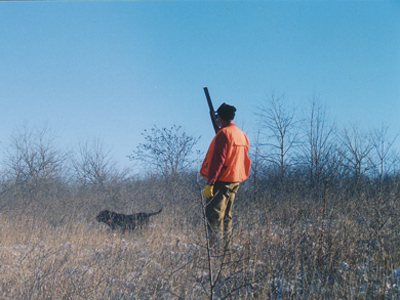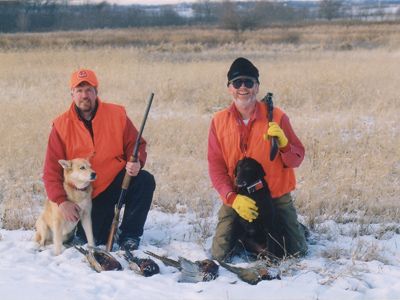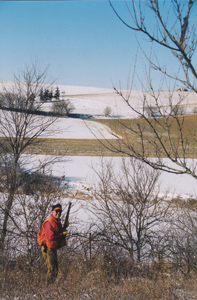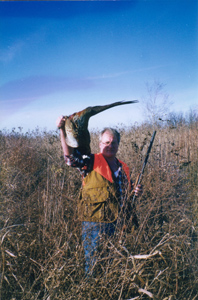“IF YOU BUILD IT, THEY WILL COME…. Wild Pheasants Thrive in Habitat-First Philosophy”
By Dick Ellis
Reader Note: For information on lodging, dining, entertainment or public hunting areas in reen County, contact Executive Director Pam Christopher the Monroe Chamber of Commerce at 608-325-7648 or thechamber@tds.net or www.monroechamber.org.
Tom Huber took a step back from the edge of the Green County woodlot and let Mocha finish the job. The tenacious work of the six year old chocolate lab had already put two wild roosters in the bag from more stereo-typical pheasant habitat just northeast of Monroe in southern Wisconsin. But her body language now needed no interpretation. Without question, another bird was holding tight to a snowy windfall. The only remaining mystery, rooster or hen, was about to find an answer.
Mocha pushed the question burrowed beneath the fallen tree and one report from Huber’s over-and-under answered it. Later, the fourth rooster for a two-man limit would also burst from a small strip of grassland, hammering home Huber’s point; embrace a habitat-first large-scale philosophy in pheasant management, and eventually the birds will migrate on their own to thrive in even the smallest of environments.
Spillover effect hunting becomes productive. And non-competitive. Establishing proper habitat first, though, remains the essential key to success.
In 1990, the year Dave Wisnefske became President of the Sugar River Valley Chapter of Pheasants Forever, he purchased a farm near Monroe. Walking the property evaluating tracks and listening to the occasional cackle, he determined that most likely a lone rooster and two hens made up the entire pheasant tenant list.
 |
 |
| Tom Huber of Monroe with chocolate lab Mocha prefers working smaller pieces of grassland habitat in Green County for wild pheasants. The Pheasants Forever member calls proper habitat the essential ingredient to the success of the wild bird in Wisconsin. Wild pheasants flourish in Green County where attention to habitat is the priority. | Outdoors writer Dick Ellis, left with Blue, and Tom Huber of Monroe, with Mocha, concluded a hunt in Green County December 3 with a limit of four roosters. Proper habitat that provides winter cover, protection from predators, food, and nesting grass is the essential key to the success of the wild bird in Wisconsin. |
After establishing prairie grass that winter, the resident flock had grown to three roosters and four hens. A year later, Wisnefske kicked up a flock of 20 wild birds. A year later, with surrounding state habitat work and area releases of wild pheasants from Iowa supplementing already established birds, Wisnefske’s property held 70 pheasants.
Since, with wild pheasant population increases and decreases correlating with fluctuating weather during spring nesting seasons, at least 30 to 40 pheasants survive overwinter on the local parcel annually. The number climbs as high as 100.
“I’ve seen a ten-fold increase on my property in wild pheasants,” he said. “Habitat is the key. If you build these fields of dreams, the birds will come.”
Pan away from Wisnefske’s property and see the same kind of results reflected throughout Green County where habitat work has been completed on thousands of acres of public and private property by the DNR and Pheasants Forever. Proper habitat allows the birds’ protection from predators, winter cover, nesting success, and access to food.
“Getting the pheasant through winter is the key and I would say that establishing warm season grasses and planting food plots is the key to that,” Wisnefske said. “In one 25 square mile section as one example of results in Green County, we run five routes to listen for spring crowing (a population estimate method). The crow count was eight there prior to habitat work and 120 at the peak after habitat work.”
Pan away from Green County, and see the same kind of wild pheasant reestablishment results over many regions of Wisconsin where the emphasis is on establishing habitat. According to Wisnefske, the Sugar River Valley Chapter of Pheasants Forever, with 150 members is one of 20 chapters statewide with approximately 8000 members.
State chapters reach as far north as Brown County, Wausau, Menominee, Eau Claire, and Hudson. He called that far northwest region and the region from Fond du Lac to Beaver Dam and including much of southern Wisconsin centered around Madison as pheasant zones designated by the DNR for habitat and bird release work.
Pan away a final time and nationally see the same habitat philosophy implemented throughout the country. The Pheasants Forever organization includes 500 chapters and 100,000 members and is celebrating its 20th anniversary this year.
The organization was borne in 1982 out of Minnesota, Wisnefske said. The Sugar River Valley Chapter, founded in 1984, was the 163rd chapter. With the focus on habitat, Green County residents have noticed the intended result.
“Person after person after person remarks that they’re seeing pheasants where they never used to,” Wisnefske said. “Create prairie grasses with a five acre food plot and maybe 30 pheasants will flock together to make it through the winter. Then with the warmer weather, those birds explode all over the place.”
That was verified December 3 tracking long-time Sugar River Valley Pheasants Forever Chapter member Tom Huber on our hunt near Monroe. A transplant from Iowa who knows a bit about excellent pheasant hunting, Huber said his native Waterloo area of the Hawkeye State has nothing on Green County.
Huber said that the Federal Conservation Reserve Program (CRP) that has compensated farmers over much of the last two decades to leave marginal crop land fallow was a great first step toward reestablishing wild birds in Wisconsin. But, he said, recently, a greater emphasis on cultivating the proper cover on that idle acreage has been crucial to the pheasants thriving.
“Land doesn’t qualify for CRP unless it’s marginal for crops and profit,” he said. “It might have a lot of rocks or be prone to erosion. It won’t qualify if it’s a flat piece with black topsoil. Over the last six or seven years, instead of just letting that land grow fallow and not worrying about it, there may be a few rows of corn planted, and proper grasses for cover.; more accented, alternative uses of the CRP.”
 |
 |
| Tom Huber of Monroe prefers working smaller pieces of grassland habitat in Green County for wild pheasants. The Pheasants Forever member calls proper habitat the essential ingredient to the success of the wild bird in Wisconsin. Wild pheasants flourish in Green County where attention to habitat is the priority. | Proper habitat that provides winter cover, protection from predators, food, and nesting grass is the essential ingredient to the success of the wild bird in Wisconsin. Pheasants Forever, with 20 chapters throughout the state, embraces the philosophy of habitat first. |
Huber also noted that resurgence in the popularity of varmint hunting has combined with improved habitat to take even more pressure off the pheasant. Four or five hunters in Green County hunting in the winter months, he said, can take out 50 coyotes, which he called the main culprit in pheasant predation.
When it’s time to hunt, Huber has cultivated trusting relationships with landowners in Green County, predominantly on smaller parcels of property largely passed over by other hunters. The spillover affect from birds migrating from large tracks of Conservation Reserve Program (CRP) habitat, ultimately leaves more pheasants per acre on these smaller tracts, Huber believes.
“I prefer a one or two man hunt to a ten-man line hunt,” he said. “The areas I like many hunters will pass over for bigger areas. The smaller areas per square mile hold a lot more birds. You saw it today. We probably saw 25 hens and ten roosters. Coming in this morning I saw two roosters eating gravel on the side of the road. There was lots of corn around and just two little patches of grass. That’s where they came from. But large or small, habitat is the key.”
Dick’s Note: Retired physician Dave Wisnefske, President of the Sugar River Valley Chapter of Pheasants Forever, now owns Savannah Springs Nursery in Monroe, a private business establishing prairie grasses and other habitat crucial to pheasants and other wildlife. Wisnefske said that Midwest Prairie of Lake Mills is another business offering expertise in establishing prairie habitat.







